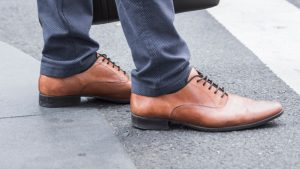Table of Contents
ToggleHow to Lace Your Wingtip Oxfords for Variable Weather

1. Loose for Warm Weather Comfort
In warmer weather, a slightly looser shoelace allows more airflow, keeping your feet cooler and preventing discomfort caused by constriction. It also enables easier movement of your feet within the shoes, reducing the risk of blisters or soreness.
2. Snug for Stability in Wet Conditions
During rainy or wet weather, tightening your Wingtip Oxfords a bit more can be beneficial. A snug fit helps prevent water from seeping into your shoes, keeping your feet drier. Additionally, a snug lace-up can enhance stability, reducing the chances of slipping on slippery surfaces.
3. Consider Flexibility
Remember, adjustability is key. Consider a lace technique that allows you to quickly and easily modify the tightness based on the weather or your comfort. For instance, the over-under lacing method provides a customizable fit, allowing you to tighten or loosen specific areas as needed.
4. Personal Comfort Matters
Lastly, trust your comfort level. Your feet can tell you a lot! If your shoes feel uncomfortable or too tight, they probably are. Likewise, if they’re too loose and causing friction, it might be time to adjust.
So,…
Adjusting the tightness of your Wingtip Oxfords’ shoelaces for variable weather conditions involves finding a happy medium between comfort and functionality. The right fit depends on the weather, your comfort preferences, and the activities you’re engaging in. Experiment with different lace-up techniques and tensions to discover what works best for you in various weather conditions.
Remember, it’s not just about functionality; it’s about feeling good in your shoes regardless of the weather. So, find that balance, and step out confidently in your Wingtip Oxfords, no matter what Mother Nature throws your way.
Tips for Perfect Shoelace Adjustments
Now that you understand the importance of adjusting your Wingtip Oxfords’ shoelaces for variable weather, let’s dive deeper into some practical tips:
1. Experiment with Different Lacing Techniques
Over-Under Lacing: This method offers adjustability, allowing you to customize the tightness across different parts of the shoe.
Gap Lacing: It lets you control the tension in specific areas, perfect for accommodating wider or narrower parts of your feet.
2. Consider the Material of Your Shoelaces
Synthetic vs. Cotton: Synthetic laces might hold better in wet conditions, while cotton ones might stretch a bit more, offering flexibility in changing weather.
3. Adapt Based on Activity
For Long Walks: Looser laces can prevent discomfort during extended periods of walking.
For Rainy Days: Tighten the laces a bit more to keep water out, especially if your shoes are not waterproof.
4. Regular Checks
Throughout the Day: Weather can change, and so can your comfort level. It’s okay to readjust as needed.
Before Activity Changes: If you’re transitioning from indoors to outdoors or vice versa, a quick lace check can ensure comfort.
5. Comfort Over Everything
Listen to Your Feet: Your comfort is key. If your feet feel constricted or uncomfortable, make adjustments accordingly.
Final Thoughts
Perfecting the art of adjusting your Wingtip Oxfords’ shoelaces for variable weather is a blend of practicality and personal comfort. Play around with different lacing techniques, consider the material of your shoelaces, and always prioritize how your feet feel. By finding that sweet spot of comfort and functionality, you’ll be ready to stride confidently through any weather condition, knowing your shoes are tailored just right for you!
Comparison tabular
Here’s a simple comparison table summarizing the different aspects of lacing your Wingtip Oxfords for variable weather conditions:
| Aspect | Loose Lacing | Snug Lacing |
|---|---|---|
| Warm Weather | Allows more airflow, keeping feet cooler. | Might feel slightly constricted, but stable. |
| Wet/Rainy Weather | Less water resistance, potential for wet feet. | Better water resistance, keeps feet drier. |
| Flexibility | Freer movement, reduced risk of blisters. | Enhanced stability, reduced slipping chances. |
| Adjustability | Easily modified for comfort. | Can be less flexible but more weather resistant. |
| Personal Comfort | Comfortable, less chance of friction. | Enhanced stability but might feel tighter. |
This table summarizes the trade-offs between loose and snug lacing in different weather conditions. Ultimately, finding the right balance between comfort, airflow, and stability is key to enjoying your Wingtip Oxfords in various weather scenarios.
Final words
Adjusting the lacing of your Wingtip Oxfords to suit variable weather is like finding the perfect seasoning for your favorite dish it’s all about balance and personal taste.
Remember, your comfort is the compass guiding this adjustment journey. Whether you opt for a looser lacing for that cooling breeze in warm weather or a snug fit for stability during rain, it’s about feeling great in your shoes, come rain or shine.
Experiment with different lacing techniques, consider the materials, and keep an eye on how your feet feel. With these simple adjustments, you’ll stride confidently through any weather, knowing your shoes are tailored to your comfort and style. Now go ahead, lace up, and step out into the world with confidence.

Mike the founder of The Shoe String Forum.com, has always had a lifelong love for shoes since he was a kid and with a fervent love for diverse brands like Adidas, Puma, Louis Vuitton, Nike, Birkenstocks, Hey Dudes, Crocs, Vans, Uggs, Converse, and New Balance, he passionately shares extensive footwear research through this platform.
Related Posts
- How tight should you shoestring Saddle Oxfords for variable weather days?
When it comes to Saddle Oxfords shoelaces and variable weather, getting the tightness just right…
- How tight should your Full brogues shoestring be for variable weather use?
When it comes to your full brogues and their shoelaces, finding the right tightness can…
- How tight should you shoestring Blucher Derbies for variable weather use?
When it comes to lacing up your Blucher Derbies, finding the perfect shoestring tightness is…
